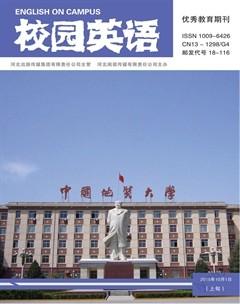From Memorization to Critical Thinking
Long Feng
【Abstract】The essay introduces the authors experiences in the UK and Canada to explain the difference of educational methods in China and western countries:from memorization to critical thinking.The author explains what the critical thinking is and what features should a critical thinker have,then give some suggestions to improve Chinese educational system.
【Key words】memorization; critical thinking; teaching method
Almost all the students in China are taught in traditional teaching method:students are not engaged in the lesson and the whole class is teacher-oriented; what the students do is listening and taking notes in the class and doing “Yes or No” exercises after class.They hardly think about why they learn and whether the teacher is right.Passive acceptance and mechanical copy can only produce machinelike students who can memorize knowledge quickly and exactly,but not generate new ideas and analyze questions.
I grow up in China and in my first thirty years I didnt realize the drawbacks of traditional Chinese teaching way till I went to the UK two years ago and work there for one year as a teacher in a middle school.After observing lots of lessons there,I found I couldnt use the same way as in China to teach British students.No matter what lessons they had,the learning atmosphere is relaxed and comfortable.No teachers required students to sit with the hands at the back or keep silent while teachers speaking; the only requirement was being active.The whole class was composed of question,discussion,reason explanation and opinion share.Teachers encouraged students to question what they taught.Though sometimes the students words were nonsense or irrelevant remarks,teachers still praised them first then gave the right answer or asked for others opinions.In this way,all the students were willing to engage in the lesson and they thought they were the person dominating the class and teachers were their guide.Besides,the design of students books there impressed me deeply.Compared with the Chinese books full of characters and theories in white and black,British students books are colorful and funny.Take the lesson “Transportation” of Science in year 5 for example:the first part is to fill in the blanks to show the responsibility of each level of government on transportation; the second part is to match the advantages and disadvantages of transportation system; the third part is to look at the graphs and answer the questions; the last part is to reading a case then make tow suggestions to help Sally lower her transportation costs but still minimize the time she spends on the road.From the above parts,we could find this is not only a science lesson,but a lesson with calculation,writing,creative thinking,logical mind and critical thinking.What the lesson offers to the students is comprehensive ability rather than memorizing ability.
This July,I went to Canada.As a student this time,I experienced the critical-thinking classes a lot.Teachers were from different institutions and taught us different fields about education.However,without exception,no teacher taught us for the whole lesson.All of them liked us to ask questions anytime during the lesson and after theory explanation,they left half an hour for us to ask questions.One month later,I found I became to like thinking more and asking why.A lively intellect and critical thinking were taking hold in my mind.
All these experiences brought me some inspiration:that is China need a radical educational reform from kindergarten to university to cultivate critical thinking ability for the students.
1.What is critical thinking?
Critical thinking is variously defined by different people.From Wikipedia,Critical thinking is clear,reasoned thinking involving critique.According to Beyer,critical thinking refers to making clear,and reasoned judgments.While performing critical thinking,ideas should be reasoned and well thought out.Critical thinking is also defined as the intellectually disciplined process of actively and skillfully conceptualizing,applying,analyzing,synthesizing,and/or evaluating information gathered from,or generated by,observation,experience,reflection,reasoning,or communication,as a guide to belief and action.
Throughout the Twentieth Century,western countries performed critical thinking instruction and consider it as part of the mission of their educational system at all levels—to varying degrees at various times.But critical thinking didnt get attention widely till the end of the twentieth century,around 1980,interest in critical thinking suddenly increased exponentially.Now,virtually all educational institutions claim to teach critical thinking.Compared with western countries,Chinese educational system lagged behind for about 30 years.Only till the early 21st century,critical thinking was introduced to China and in recent years,some educational institutions make critical thinking as one of the training goal.
2.What characteristics should a critical thinker have?
We always consider “critical” as a negative word,but the conception of critical thinking is active.Also,it does not treat critical thought as persuasion,but critical thought will often be persuasive.The future of democracy depends on it.A critical thinker usually has the following features:
1.Is open-minded and mindful of alternatives
2.Desires to be,and is,well-informed
3.Judges well the credibility of sources
4.Identifies reasons,assumptions,and conclusions
5.Asks appropriate clarifying questions
6.Judges well the quality of an argument,including its reasons,assumptions,evidence,and their degree of support for the conclusion
7.Can well develop and defend a reasonable position regarding a belief or an action,doing justice to challenges
8.Plans and conducts experiments well
9.Defines terms in a way appropriate for the context
10.Draws conclusions when warranted – but with caution
The above 10 norms are also the assessment for a genuine critical thinker.For all the teachers,its a long way to go to cultivate Chinese students with critical thinking.It also needs the Ministry of Education give policy support and perform a radical educational reform.
References:
[1]Ennis,Robert H.(2013c).Critical thinking across the curriculum:The Wisdom CTAC Program.Inquiry:Critical Thinking across the Curriculum,28,2,25-45.
[2]Kennedy,M,Fisher,M.B.& Ennis,R.H.(1991).Critical thinking:Literature review and needed research.In L.Idol and B.F.Jones(Eds.),Educational values and cognitive instruction:Implications for reform.Hillsdale,NJ:Erlbaum.Pp.11-40.
[3]Norris,Stephen P.and Ennis,Robert H.(1989).Evaluating critical thinking.Pacific Grove,CA:Midwest Publications.
[4]Fischer,J.M.and Ennis,R.H.(1986).Causation and liability.Philosophy and Public Affairs,15(1),33-40.
[5]Tomko,T.N.and Ennis,R.H.(1980).Evaluation of informal logic competence.In J.A.Blair & R.Johnson(Eds.),Informal logic:The first international symposium.Inverness,CA:Edgepress.Pp.113-144.

